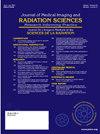Clarity in Career Choices: Examining Radiographers' Experiences with Pre-specialisation Modality Observation
IF 2
Q3 RADIOLOGY, NUCLEAR MEDICINE & MEDICAL IMAGING
Journal of Medical Imaging and Radiation Sciences
Pub Date : 2025-07-01
DOI:10.1016/j.jmir.2025.102059
引用次数: 0
Abstract
Aim
Pre-specialisation modality observation, conducted before radiographers choose their specialisation after attaining full registration with the Allied Health Professions Council (AHPC), can play a crucial role in career decision-making processes. However, different modalities conduct the observation differently, potentially compromising the efficacy of these learning opportunities. This study aimed to retrospectively investigate radiographers' perceptions of pre-specialisation modality observation, the effectiveness of these observations in informing their choices, and provide recommendations for improvement.
Methods
A mixed-method study surveyed radiographers from diverse specialities who undertook pre-specialisation modality observations between 2022-2024, after achieving full AHPC registration but before selecting their specialisation. The survey used a 5-point Likert scale (1=strongly disagree, 5=strongly agree) to evaluate consistency, usefulness, and adequacy of observations. Open-ended questions captured qualitative insights on experiences and suggestions for improvement.
Results
Nineteen radiographers participated in the survey. 63.2% had less than 2 years of experience in their chosen speciality, while 36.8% were awaiting specialisation. Among the participants (n=12) who observed more than one modality, 66.66% found the experience to be uniform across specialisations, with 33.33% perceiving a moderate level of variation in their observation experiences. All radiographers felt the observation was useful. However, only 36.8% felt the observations had provided adequate information for their decision-making. Key inconsistencies identified were duration of observation, activities involved, staff interaction, and information provided. The most valuable elements observed included observing procedures, discussions with staff, understanding workflow, and understanding career progression. 47.4% of participants favoured standardisation for future observations, while 31.6% disagree and 21% remains neutral. 52.6% reported feeling confident in their decision to specialise in their chosen modality after completing the observation.
Conclusion
Pre-specialisation modality observations are perceived as useful there is significant potential to enhance their effectiveness in supporting radiographers' career decisions. While there is a desire for more consistency, a one-size-fits-all approach may not be ideal. A balanced approach offering flexibility while ensuring core elements included across all specialities might be most beneficial. Addressing the identified inconsistencies and incorporating the most valued elements could lead to better-informed specialisation choices, potentially improve long-term career satisfaction among radiographers
清晰的职业选择:检查放射技师的经验与专业前模式观察
专科前模式观察是在放射技师获得联合健康专业委员会(AHPC)的正式注册后选择专业之前进行的,在职业决策过程中起着至关重要的作用。然而,不同的模式进行不同的观察,潜在地损害这些学习机会的效力。本研究旨在回顾性调查放射技师对专业化前模式观察的看法,这些观察在告知他们选择时的有效性,并提供改进建议。方法一项混合方法研究调查了来自不同专业的放射技师,他们在获得AHPC全面注册后,但在选择专业之前,在2022-2024年间进行了预专业模式观察。该调查使用5分李克特量表(1=强烈不同意,5=强烈同意)来评估观察结果的一致性、有用性和充分性。开放式问题捕获了对经验和改进建议的定性见解。结果共有19名放射技师参与调查。63.2%的学生所选专业的工作经验不足两年,而36.8%的学生正在等待进入专业。在观察多个模态的参与者(n=12)中,66.66%的人发现不同专业的经验是一致的,33.33%的人认为他们的观察经验有中等程度的变化。所有的放射技师都觉得这个观察结果很有用。然而,只有36.8%的人认为这些观察为他们的决策提供了充分的信息。确定的主要不一致之处是观察的持续时间、涉及的活动、工作人员的互动和提供的信息。观察到的最有价值的因素包括观察程序、与员工讨论、理解工作流程和理解职业发展。47.4%的参与者赞成对未来的观察进行标准化,而31.6%的人不同意,21%的人保持中立。52.6%的人报告说,在完成观察后,他们对自己选择的专业模式有信心。结论专业前模式观察被认为是有用的,在支持放射技师职业决策方面具有显著的潜力。虽然人们希望有更多的一致性,但一刀切的方法可能并不理想。在确保所有专业都包含核心元素的同时,提供灵活性的平衡方法可能是最有益的。解决已确定的不一致并纳入最有价值的因素可能会导致更明智的专业选择,潜在地提高放射技师的长期职业满意度
本文章由计算机程序翻译,如有差异,请以英文原文为准。
求助全文
约1分钟内获得全文
求助全文
来源期刊

Journal of Medical Imaging and Radiation Sciences
RADIOLOGY, NUCLEAR MEDICINE & MEDICAL IMAGING-
CiteScore
2.30
自引率
11.10%
发文量
231
审稿时长
53 days
期刊介绍:
Journal of Medical Imaging and Radiation Sciences is the official peer-reviewed journal of the Canadian Association of Medical Radiation Technologists. This journal is published four times a year and is circulated to approximately 11,000 medical radiation technologists, libraries and radiology departments throughout Canada, the United States and overseas. The Journal publishes articles on recent research, new technology and techniques, professional practices, technologists viewpoints as well as relevant book reviews.
 求助内容:
求助内容: 应助结果提醒方式:
应助结果提醒方式:


